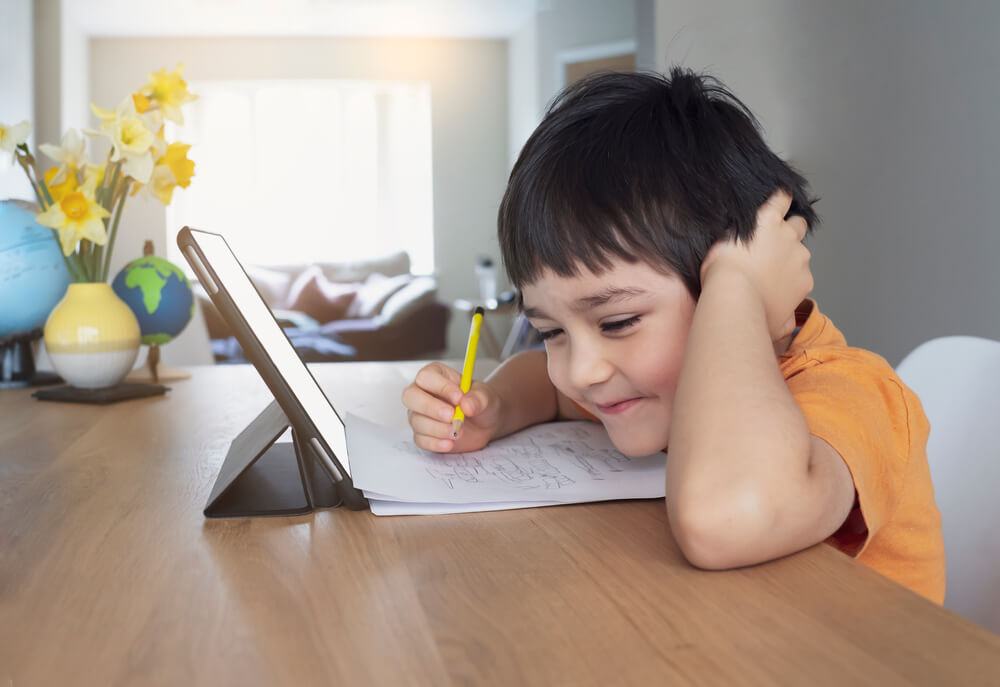
Teaching with kids at home: 12+ survival tips
Many schools are closed due to the new coronavirus, yet it still has been a very busy week for teachers who continue to provide education to their students through remote teaching. Thousands of students are out of school as well, and teachers are challenged to figure out how they can keep their students occupied while at home.
Most teachers are women, and many of them have young children. In fact, 48% of public school teachers have children living at home, as reported by the Brookings Institutions. With teachers now transitioned to online teaching, they are now carrying two heavy roles: teaching and parenting. The latter can be overwhelming already, even more so if it collides with teaching.
Teaching has become pretty complicated for teachers now that they have to teach at home while having to attend their responsibilities as parents. This is even more difficult for teachers who are home alone with kids.
And although this can be somewhat complex to deal with, it doesn’t necessarily mean that it’s impossible to teach from home while providing caregiving responsibilities for children.
If you’re a teacher who is trying to figure out how to balance online teaching with parenting, then this guide is for you.
Table of Contents
Your kids are yet adjusting to the sudden shift…
If it was a dizzying transition for you, then your kids might have been feeling the same way. They aren’t used to being at home in the morning when they are usually being sent off to school. And when they see you home, they might not think that you’re actually working.
Online teaching really does bring unique challenges, but they are things you can do to minimize the difficulty, all the while not compromising your responsibilities as a parent.
We at All Digital School are working to continuously provide you with all your online teaching needsーfrom guides like this to tools and resources online.
Here’s what you can do
Accept your chaos (and own it!)
If your kids are with you in the same room while you are facilitating your online class, then you have to realize that their heads might pop into your students’ field of view anytime. And you can’t expect them to hush. Your kid might sing nursery rhymes, read his favorite book loudly, or constantly make you look at that LEGO house they’ve built or that horse they made out of clay.
When students see you in your parent mode is good for them. And your kids seeing you in your teacher mode is also good for them.
Your schedule should stay unchanged
With you being in the comfort of your own, you could easily lose track of your schedule and spend more time teaching your students than you should ー or it could be the other way around. The best thing to do is to work the same hours every day.
Set office hours and teaching hours for your students and school. You should also set a strict schedule for homeschooling.
Some schools expect teachers to replicate a regular school day schedule in a virtual environment and hold office hours at least three times a week at flexible times. Such flexibility is essential for teachers. You might want to talk to your school principal about that.
Keep in mind that responding to student emails are to be considered teaching time. Communication with students is crucial to their academic success, but the virtual environment could make you set aside time management.
The time that you invest in replying to email questions should not be counted as “extra work” (just as how fielding questions to your students after your lecture is not “extra” teaching).
If you do not want to overspend time in responding to email questions, consider populating your online portal with plenty of instructional guidelines. Do not hesitate to direct your students to specific instructional material.
If you still find it difficult to manage your teaching time, talk to your school principal. They may be able to set up a virtual classroom with schedules that fit yours and your students.
Create separate space for home teaching and virtual teaching
Having a place at your home for remote teaching can help you stay focused on your work, and also keep your teaching materials organized. A separate room dedicated to your online teaching is good, but with kids in the house, setting up a home workplace could be rather tricky.
Setting up a space for your teaching doesn’t always mean you have to be in a separate room form your kids. You could be in one room and create a “zone.” For example, you could be in one corner and your kids in the other corner. Place educational toys in your kids’ area. You may even want to set up another computer for your kid (depending on their age and ability to use your device).
You want your background to be neat, preferably a wall with neutral color, so that your students won’t get distracted with whatever that’s happening in your home. Using a noise-canceling device is also important.
If you have to attend to your children due to matters that require urgent attention, then do not be afraid to tell your students about it.
You might want to consider collaboration with your co-teachers to ease each other’s burdens. For example, if you are available during the day, you could focus on connecting with your students, while another teacher videotapes lectures at night that students could watch on their own time.
Give your kids fun learning activities they can spend time on
Kids will always crave for your attention if they are left with nothing to get busy on. Get your kids excited about discovering something new (like skills, talent, or information) by giving them fun activities that could also disguise as fun time.

If you have a preschooler, you may have him start with basic games that will teach him farm animals, colors, ABCs, 123s, and shapes. You can hand him a soundboard book. If screentime doesn’t bother you, you can introduce educational games for toddlers for your kid, such as LingoKids and Zoolingo.
You may also have your kids watch educational videos on YouTube Learning, YouTube Kids, or Netflix Kids. To learn more about what you can do to keep your kids entertained, read our blog post How To Keep Kids Entertained At Home During COVID-19 School Closures.
Keep them occupied by assigning them engaging home chores
When your kids are occupied with an activity, you are more likely to focus on your online teaching. Assigning your kids household chores does not only give them something to do but it also teaches them the concept of work ethic.
Not just that, household chores also teach kids practical skills and important life skills. They will also develop independence and practice cooperative learning. But let’s get real here… chores aren’t very fun to do, so you have to make them fun. And by fun, we mean creative.
Kids love it when they are enjoying what they do, so you want to ensure they get fun from doing household chores. You’ll likely be occupied with your online lessons as well, so assigning your kids chores that do not need that much supervision is ideal.
Chore Charts are creative chores that your kids can enjoy. Giving them rewards for tasks they complete is a good way to keep them excited doing the chores.
READ: Creative Chores for Kids: How to Make Chores Fun
Let your kids get bored
This comes in contrast to the things we’ve just discussed, but letting your kids get bored is actually a great way to hush them.
Some households do not have enough laptops, PCs, and other techs that allow children to access learning platforms. Chris Dyson, a headteacher of Parklands Primary School, Leeds, suggests to “let kids have a holiday and enjoy themselves until they get bored.”
When kids get bored, they are likely to get on to learning they have been set. That’s when home activities come in handy. Children are more likely to work on their assignments to ease boredom.
Sit down and talk to your kids
Sometimes, all it takes is a serious talk with the kids. As mentioned before, your children are just as surprised as you when they learned they have to stay home for an indefinite period due to the new coronavirus. And just like you, they are still fine-tuning to the new normal ーslow mornings, homeschooling, and seeing you working (and teaching in a virtual classroom) at the dining table.
They’ve known you as a teacher when you’re in the school but seeing you in your “teacher mode” when you’re at home could be something new to them.
What you can do is sit your kids down and talk about teaching your class online. You might even have to discuss what COVID-19 is, why they’re stuck at home, and why they need to keep things down when you’re in your class.
Of course, you will want to reassure your kids that they can always call you if they need help with something. They have to understand how important it is for you that they minimize their noise and also know that you are there when they need you.
When facilitating your online class, give the class intervals. The quick breaks could mean rehydrating, pee time, or quick bonding time with your kids.
Check in with your kids every morning (and throughout the day)
Teaching online might have gotten you overwhelmed. Now that you have to do almost everything online, you tend to spend more time understanding how Zoom works, troubleshooting your speaker, searching for online teaching resources, and creating online lesson plans.

We understand that it’s a heavy load to bear, and because of the complexity of digital teaching, you might be spending too much time figuring out the nuts and bolts of this remote teaching thing.
But that shouldn’t be a reason for you to neglect—or spend less time—with your kids. True, setting an academic goal for each day is good, but establishing a sense of belonging, connection, and well-being is a crucial precursor to learning. You want to make sure that you provide not just the academic and emotional needs of your students, but most importantly, the needs of your kids as well.
So before you start the day, make sure to check your child’s emotions. For instance, is your kid lonely and upset? Research suggests that upset kids won’t be as productive as learners.
Try this: implement an at-home version of “greeting at the door.” Start your day checking in with your child and asking how they are feeling.
Notice good school habits in your kids
What does your child like to do (and can do independently)? Does your child like sitting and reading quietly? Then make sure they have enough good books to read. Is your child excited about jigsaw puzzles? Do they like solving math problems?
The school at home system might continue for at least several months. Help your kids to have time to develop their skills by building in time for fun and passion projects.
Household activities like decorating and organizing give kids the opportunity to develop problem-solving skills. Research also shows that highly engaging activities can help improve empathy, mental focus, language skills, and creativity.
So while you’re hustling at your online teaching work, allow your kids at home to spend time building and improving their skills. The American Academy of Pediatrics recommends giving kids unstructured play with few rules and lots of room for imagination. This will help your kids practice social-emotional skills and creative thinking.
How about a painting contest?
Have you heard about this dad who watched his kids so mom could go shopping? Mom returns home only to find out her husband was sleeping, and the kids are drawing him “posing.”
Michael Weber Jr, the dad, had just returned home from a 12-hour night shift. We could imagine the level of exhaustion that he was carrying. His wife needed to get some grocery shopping done, so someone had to take care of the kids, and so he volunteered.
Weber Jr always tries to come up with fun and creative ways to get things done (and get time for himself). So he got his kids to sit still and paint him while he’s “posing,” AKA naps. The best painting gets a prize, of course!
For some, that’s bad parenting, but for many others, that was a brilliant idea and genius parenting. You could do the same, except your “pose” is when you’re having an online class.

Not that your kids should draw you, but the concept could be similar to that. You can have your kids sit down and have them paint (it could be a painting of one specific subject or just anything they want to paint).
Painting is a great hobby that kids can spend time on while you’re teaching your class. Alternatively, you can let your kids complete puzzles or build a community using LEGO bricks.
Let your child engage with other peers
School closures and being stuck at home may have been difficult for your kids already. They haven’t had any close contact with their friends, no playdates, and absolutely no playgrounds.
Give them time to engage with their friends through the available technology. You can call the parents of your kid’s friends or classmates, and set up a schedule when your kids can have fun even through videoconferencing.
Your kid could be having fun with their friends while you’re conducting your online class. Use communication tools that allow you to monitor your kid’s activities, such as Messenger Kids.
Get your child on board with virtual tours
You don’t want to compromise your teaching quality when you’re with your students. Hence, keeping your child at home busy is crucial. But of course, you don’t want them to just engage in anything, but something that they can learn something from.
Taking them to online field trips, virtual tours, art lessons, nature cams, and author read aloud are some of the online activities your kids might look forward to.
We at Digital School are working and have created a list of virtual field trips. To learn more about virtual field trips, read our blog post: Virtual Field Trips 101: Ultimate Guide for Teachers.
After your online class…
So you’ve managed to finish hours of discussions with your students online and kept your kids (mostly) managed throughout your online class, what now?
Check in with your kids again and ask them what they are feeling. Are they upset? Did they think you were ignoring them? Did they have a great time chatting with their friends?
Take your teacher’s hat off after your online class. Praise your children’s efforts and behavior. Acknowledge the things they have done throughout the day.
Spend extra time together with your child. Bring out the board game, do some artwork, make a meal together, bake cookies, do a jigsaw, or dance or make a video.
If you need more help, we know exactly where you should go
Remote teaching may be something that you lack experience of. This may be a new complex thing you’re still trying to figure out. If the transition has been difficult for you, then it’s fair to think that your kids are feeling the same way.
More and more schools are closing due to the pandemic, and distance learning is expected to last longer. This could lay another set of challenges, especially for parents that also teach students online. But just because you have to manage two roles doesn’t mean you can’t do it.
You CAN be a great parent while being a great teacher. It is during these challenging times that teachers and parents can help one another to ensure education continuity and success among children.
If you need more help in facilitating remote teaching, our community of parents, educators, and professionals are more willing to help you. By registering on All Digital School (which, by the way, is super easy and 100% free), you’ll get access to community boards where you can ask questions, get answers, and share your experiences.
You can connect with other teachers or even help parents that need support during this pandemic.
You can also create an account using Facebook or Google buttons below:
Do you have any more tips you’d like to share with us? Comment below or share your ideas in our community forum!












Comments are closed.